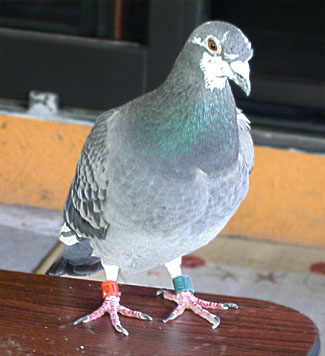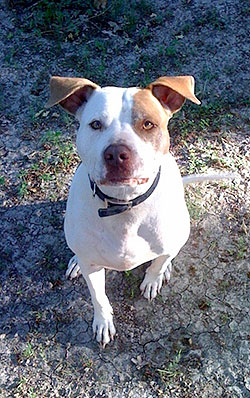 We had an unexpected visitor during the hot spell in May—a homing pigeon who got lost in a race. Larry was in front of the house when he saw a pigeon land on his car and stare at him fixedly. Then the bird tried to walk into our garage but the door was closed. Larry held him while I read the bands on his legs, and then we put him in a cage with some water while we tracked down his owner.
We had an unexpected visitor during the hot spell in May—a homing pigeon who got lost in a race. Larry was in front of the house when he saw a pigeon land on his car and stare at him fixedly. Then the bird tried to walk into our garage but the door was closed. Larry held him while I read the bands on his legs, and then we put him in a cage with some water while we tracked down his owner.
We found out he was from San Diego. The race started on the road to Las Vegas, and the pigeons were supposed to fly home to San Diego. This one landed in northeast Los Angeles instead. The San Diego racing team asked us to keep him a few days until the weather cooled off, feed and water him, and he’d fly home when he felt better.
Homer (yes, I named him) had a different plan.
He busted out of the cage when Larry tried to refill his water, but he didn’t fly back to San Diego. He liked our patio, where he perched and pooped on all the furniture. He went off at night to roost somewhere, but came back midmorning for breakfast. After dinner (he liked it between 5 and 6 p.m.) he’d hang out with us for a while, have a little nap, and then go off for the night. This went on for a few days. We called and e-mailed pigeon fanciers around L.A. and San Diego, asking them to take him. No one responded. So on Saturday Larry got him back in the cage—he put food in the cage and Homer walked right in—and drove him 17 miles south (toward San Diego) on the 710 freeway. He stopped at a park and set Homer free. Homer took off flying south. Larry breathed a sigh of relief.
Larry drove home, a little sad. He stopped to buy a sandwich, went out on the patio, set out his lunch, opened his magazine, settled in for a quiet lunch, and Homer strolled across the patio towards him.
Yes, he had flown home to us.
I think he was probably really happy he had trained us so well. Food, water, an invigorating flight. What more could a homing pigeon want?
Unfortunately, we are really not equipped to handle a homing pigeon. Plus, we were about to go away for two weeks, and while my assistant Karen is happy to keep our bird baths filled, I’m not sure she would have wanted to drive Homer 15 miles a day so he could have some exercise.
So Larry called the president of the Los Angeles Pigeon Society, and he came out and picked up Homer. He knows people in San Diego, and will make sure Homer gets back to his owner.
We’re sad Homer’s not here, but it’s really nice to have taken the sheets off the outdoor furniture—it is amazing how much a pigeon can poop!
As an animal communicator, I was mildly surprised at how uninterested Homer was in communicating with me in my “normal” way. I don’t have great success communicating with birds anyway—they really have a completely different view of the world to mammals, and their 360° awareness which helps them fly makes their brains (or whatever frequency they communicate on) very hard for my human brain to navigate.
Also, Homer wasn’t a pet and he wasn’t a wild animal. He was a working animal, I guess; one who is well fed and taken care of, but does not have an emotional attachment with his humans. (I assume the human didn’t have an emotional attachment, because he did not race up here—a mere 2 hours!—to get Homer back.) However, he definitely liked human company. He sat with us on the patio, walked around us and pecked at our feet, and at one point tried to sit on my shoulder—I discouraged that.
I’m still not sure what to make of the experience. It was a reminder of interconnections, and of how humans are responsible for the animals we breed to no longer be able to live by themselves in the wild. And of how even short interactions with another species can provide many entertaining memories.

 A man walks his three small dogs by our house every morning. They are not leashed—they trot along a few feet in front of him, sniffing the grass and trees. But they are fully aware of him as the pack leader. They check on him every few feet, looking back to see if he’s still there, if they’re all still moving in the right direction.
A man walks his three small dogs by our house every morning. They are not leashed—they trot along a few feet in front of him, sniffing the grass and trees. But they are fully aware of him as the pack leader. They check on him every few feet, looking back to see if he’s still there, if they’re all still moving in the right direction.